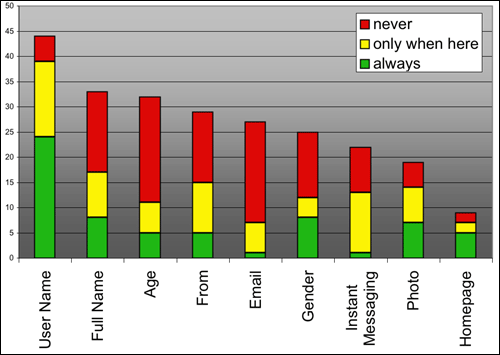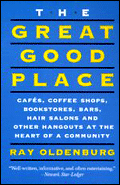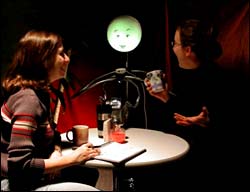Our research: PlaceSite, Inc. grew out of Project PlaceSite, a final Masters project undertaken by two of the founders at U.C. Berkeley.
We went into the research to chip away at two key long-term research questions:
1) What information, if any, would people like to share digitally with others in the same public place? Social scientists have studied people's face-to-face behavior for decades, and online social behavior has been the subject of countless papers and research projects over the past 20+ years. But what of the new hybrid: face-to-face behavior enhanced on the fly by digitally-mediated interaction? Mobile phones, laptops and handheld computers are new enough that there's still plenty of research to be done in this hybrid realm.
2) How will the introduction of a digital information service by, for and about people in a physical café affect social interactions in that café?
PlaceSite also provides new explorations of much bigger questions:
1) Many have complained that use of certain technologies, including laptops and mobile phones, insulate people from others nearby, thereby weakening neighborhood community and detracting from the ambience of public and semipublic gathering places. (For a full explanation of this, see "The Zombie Effect" on the key concepts page.) As computation continues to move beyond the desktop and into our everyday environments, can we use these technologies to strengthen local community?
2) As pervasive computing becomes more of a reality (i.e., as networked digital communication pervades our real-world physical spaces and places), how can we maximize social benefit, and minimize any social harm, that accompanies these developments? So far, we've tapped knowledge from the fields of urban planning, architecture, the social sciences and software design to develop basic design philosophy starting points for hybrid online/real-world place design. We hope to refine these strategies for minimizing harm and maximizing benefit, as the project progresses.
3) What social changes will accompany pervasive computing? How will it affect the way people interact with one another and with the city? How will awareness of physical proximity alter the ways in which people interact online? How will digital connections among people in the same room affect their face-to-face interaction? How will these things affect comfort, community, and people’s experience of a place?
How did you tackle these goals?
We gathered "before" data, using interviews, surveys and field observations to learn about current wi-fi café use in the San Francisco Bay area in general, as well as specifically in the first café where we introduced the PlaceSite system.
During and after launch of PlaceSite we conducted further surveys, interviews and observations of the people in the target café and the surrounding area. This included face-to-face observations as well as public use of the information system. We also encouraged participants to contact us with any questions or concerns, requests or recommendations.
Now, we're redesigning the core PlaceSite software, based on the observations described above, to further support the ways in which people use the system. We will release the core PlaceSite code as an open source project, and we're working on an installer package that will make it easy for any café owner with a computer, an Internet connection and a $50 Linksys WRT54G wi-fi router to set up her own PlaceSite.
What did you learn from your research?
We'll publish a longer, formal paper conveying our results. But here are a few highlights:
• 68 percent of respondents in the Bay Area, and 89 percent of respondents in the Seattle area, expressed some interest in sharing personal information with other wi-fi users nearby. But only 15 percent in the Bay Area, 12 percent in the Seattle area, expressed strong interest in participating in such activity.
• People liked to use our "only share when I'm here" privacy setting, a feature that most social networking services can't offer. The following chart illustrates how participants in the cafe rollout at A'Cuppa Tea in Berkeley used this setting. The bars show how many people filled in each listed field. Colors indicate how many of these pieces of information were set to each privacy setting. (The chart represents people's settings as of one moment in time: a "snapshot" taken during late May 2005. Remember that people are encouraged to change their settings on the fly; so people often would put a piece of information into the system, but keep it hidden some times and reveal it other times).

• During interviews, cafe patrons suggested many other uses and venues for PlaceSite, including municipal wi-fi clouds, Korean PC Baangs, classrooms and dormitories, conferences, airports and airplanes.
• Users also requested other features. Repeated suggestions included those for built-in chat, music sharing, other forms of neighborhood content, and proximity alerts when friends are nearby.
Based on these intriguing results, and based on increased buzz, investment and interest in the social benefits possible via wi-fi applications, we decided to continue on with PlaceSite as a company. During the summer of 2005 we expanded the founding team, and PlaceSite, Inc. was incorporated in September, 2005.
Others' research: Here's a summary of work that has strongly influenced us, and that explores territory close to our own:
 Ray
Oldenburg's "The Great Good Place: cafés, Coffee Shops, Bookstores,
Bars, Hair Salons and Other Hangouts at the Heart of a Community"
- In this book Oldenburg, a sociologist at the University of
West Florida, introduced the concept of the Third
Place, a semipublic gathering place beyond the the “first”
and “second” places of the home and the office. Oldenburg
explained the importance of third places such as cafés in the health
of neighborhoods, and he described how third places have declined in recent
years, particularly in the United States. The concept of the Third Place
is central to our project; see the key
concepts page for a full explanation of the concept.
Ray
Oldenburg's "The Great Good Place: cafés, Coffee Shops, Bookstores,
Bars, Hair Salons and Other Hangouts at the Heart of a Community"
- In this book Oldenburg, a sociologist at the University of
West Florida, introduced the concept of the Third
Place, a semipublic gathering place beyond the the “first”
and “second” places of the home and the office. Oldenburg
explained the importance of third places such as cafés in the health
of neighborhoods, and he described how third places have declined in recent
years, particularly in the United States. The concept of the Third Place
is central to our project; see the key
concepts page for a full explanation of the concept.
William Whyte - This sociologist is one of the most reknowned scholars of human behavior in the city, particularly within public spaces. His 16-year study of public spaces in New York, the Street Life Project, and that study's resulting book, The Social Life of Small Urban Spaces, are considered classics in the field of urban planning. The book lays out core elements of a successful public space, including the notioon of "building along the path."
Jane Jacobs - Jacobs' book The Death and Life of Great American Cities is a classic in the urban planning field. It examines social activity in modern American cities and argues that certain technological developments and trends in architecture and urban planning during the 20th Century did great damage to cities, leading to loss of humanity and the sense of place, and increases in crime. In particular she implicates automobile-focused development and "urban renewal policies" that infected the country in an effort to "save" cities, but instead had the opposite effect. Paradoxically these policies were repeated over and over, even though they failed.
Jacobs claimed that such negative trends could be reversed through, among other things, more mixing of land uses and better design of public spaces and the contextual relations between spaces. One theme Jacobs explores is the positive impact brought about when people in the neighborhood gather on sidewalks and in other open public spaces.
Christopher Alexander - This Berkeley architecture professor-emeritus is famous for a system he developed to allow anyone (not just architects) to design and build sucessful, healthy places at any scale. Core to this system, described most famously in A Pattern Language: Towns, Buildings, Construction, was the idea that construction projects should not be restricted to professional architects, that lay people in the community that will be affected by a project should design the project. Alexander believed that local context was best understood by the locals, and that this context was key to the design of successful buildings, streets and neighborhoods. He argued that many modern architects lost touch with the people they were supposedly serving, and that "most of the wonderful places of the world were not made by architects but by the people."
Alexander's "Pattern Language" distills wisdom from the fields of architecture and urban planning into a series of "patterns" that can be applied in series and customized to guide the design of almost any urban design or construction project. Each pattern conveys concepts and designs that have been proven to work in the real world. Not only do these patterns provide advice, but they form a common language that allows people from different fields and classes to effectively speak to one another about, and work together on, a project or a design problem within a project.
Adaptations of Alexander's pattern language idea have been wildly popular in the field of software design and engineering, as a way of recording and communicating proven design knowledge among professionals. Strangely enough, most of the software design patterns literature is written by and for professional software programmers. It rarely discusses the people who will use the software and it's completely inaccessible to these people, even though involvement of the lay person was central to the philosophy that drove Alexander's original pattern language.
Alexander's general philosophy of involving the community in design were strong inspirations for us. Also, two patterns from A Pattern Language had specific impacts on the design Project PlaceSite:
Entrance Room- This describes a sort of room that people pass through when entering and exiting a building, a room "both inside the building and outside it" that forms a welcoming transition from the building to the outside world. A good entrance room "marks the entrance and straddles the boundary between indoors and outdoors, covering some space outdoors and some space indoors."
Likewise, a PlaceSite comes between the real-word café the viewer inhabits, and the vast outside world of cyberspace that the user steps into from that place. In one sense the PlaceSite page and its attached features are a sort of Entrance Room, a digital reflection of the real-world place that gives the transition to "placeless" cyberspace a humane, local flavor. The Entrance Room concept was core to the birth of Project PlaceSite.
Public Outdoor Room - This pattern describes an inviting, simple, partially-enclosed outdoor spot "where hanging out.. in public outside is possible." A successful Public Outdoor Room juts up against pathways that many people use, which fits into our "build along the path" key concept. Such a place should be "defined but not too defined" -- people should be able to notice there's pleasant public space there to stop and sit or stand and hang out, but it should be minimally designed so that people can use it for varying purposes -- so the people who use it can tailor the space. The overriding character of the place should emerge from the people, not from eye-catching design elements. This was a key driver behind our minimalist design and our "seeds before trees" key concept.
Keith Hampton and Barry Wellman's Neighboring in Netville was a fascinating study that explored how the presence of a shared online experience can strengthen neighborhood social ties. In the study, houses in a subdivision outside Toronto were outfitted with computers and residents were signed up in an online neighborhood discussion forum by, for and about people in that subdivision exclusively. Residents who had access to the system became substantially more connected to their neighborhood community: as compared with residents who weren't online they recognized more people in the subdivision by name, they regularly chatted with more people in the subdivision, and they visited more local people face to face.
 Kyratso G. Karahalios' Chit
Chat Club was an MIT research project that explored the augmentation
of a real-world café with online digital services. The project
involved outfitting a café with "avatar seats," devices
that resemble robots next to the café tables. Each avatar seat
included a video camera and microphone. This allowed a faraway person
to interact with people in the café, using the avatar as a physical
proxy for the remote person. Remote users connected to an avatar seat
via a Web interface that included a video display of the chair's "point
of view" in the café. Controls on the Web site allowed a remote
person to display a range of basic facial expressions on an avatar's "face"
in the café . In this way, people in the café could sit
near an "avatar" chair and carry on a conversation that included
a faraway person.
Kyratso G. Karahalios' Chit
Chat Club was an MIT research project that explored the augmentation
of a real-world café with online digital services. The project
involved outfitting a café with "avatar seats," devices
that resemble robots next to the café tables. Each avatar seat
included a video camera and microphone. This allowed a faraway person
to interact with people in the café, using the avatar as a physical
proxy for the remote person. Remote users connected to an avatar seat
via a Web interface that included a video display of the chair's "point
of view" in the café. Controls on the Web site allowed a remote
person to display a range of basic facial expressions on an avatar's "face"
in the café . In this way, people in the café could sit
near an "avatar" chair and carry on a conversation that included
a faraway person.
The Urban Atmospheres initiative at Intel Research Berkeley examines "technological urban spaces" that are emerging as our cities become enhanced with digital services enabled by mobile networked devices and networked artifacts embedded in the environment. The initiative involves instigation of Urban Probes, "a lightweight, provocative, intervention methodology designed to rapidly deconstruct urban situations, reveal new opportunities for technology in urban spaces, and guide future long term research in urban computing."
Two associated Intel Research Berkeley undertakings that influenced and inspired our project were the Familiar Stranger project Jabberwocky by Eric Paulos and Elizabeth Goodman. Both involved the use of mobile devices to notify people when they're near what social psychologist Stanley Milgram called "familiar strangers:" people who we see each day in the urban environment but who we don't talk to or get to know. Like PlaceSite, these projects raise consciousness of the nearby people and groups that we habitually dwell among in the city.
Howard Rheingold helped inspired PlaceSite through his visions of digitally-enhanced community-building laid out in The Virtual Community, and through his writings about emerging forms of social activity enhanced by networked mobilie devices, as described in Smart Mobs.
[ more to come... ]